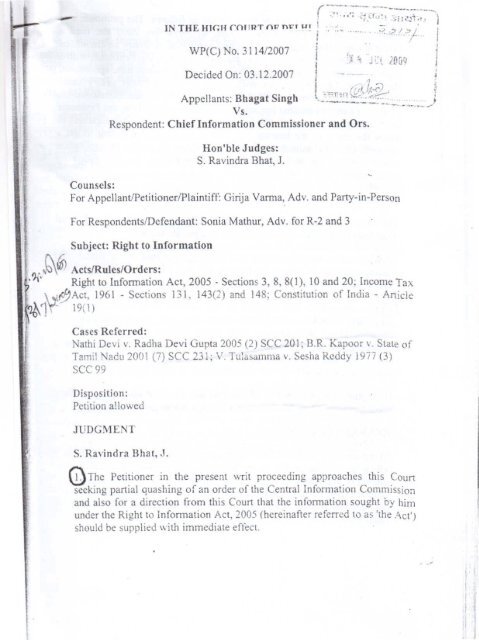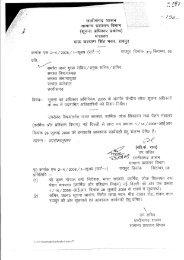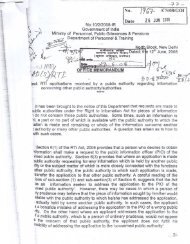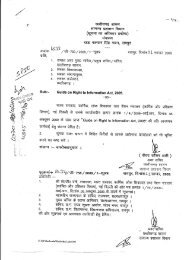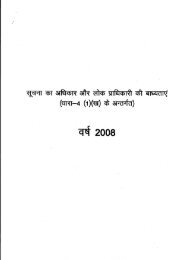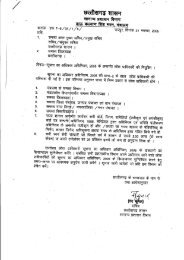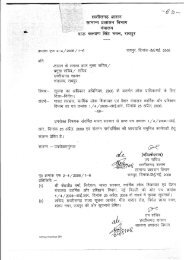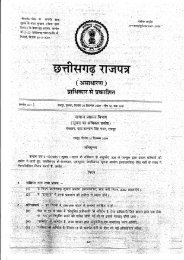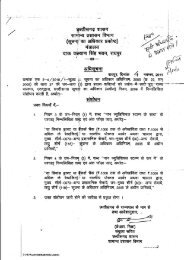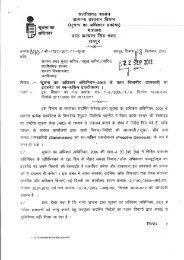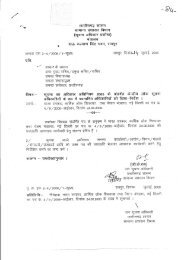1r" 19(\) - CG State Information Commission
1r" 19(\) - CG State Information Commission
1r" 19(\) - CG State Information Commission
You also want an ePaper? Increase the reach of your titles
YUMPU automatically turns print PDFs into web optimized ePapers that Google loves.
-<br />
WP(C) No. 3114/2007<br />
'". ';ol.i<br />
, .<br />
Decided On: 03.12.2007<br />
Appellants: Bhagat Singh<br />
Vs.<br />
Respondent: Chief <strong>Information</strong> <strong>Commission</strong>er and Ors.<br />
Ron'ble Judges:<br />
S. Ravindra Bhat, J.<br />
Counsels:<br />
For AppellantJPetitioneriPlaintiff: Girija Vanna, Adv. and Party-in-Person<br />
For Respondents/Defendant: Sonia Mathur, Adv. for R-2 and 3<br />
Subject: Right to <strong>Information</strong><br />
•,~~ ActslRules/Orders:<br />
'!i~ Right to <strong>Information</strong> Act, 2005 - Sections 3, 8, 8(1),10 and 20; Income Tax<br />
\ ,1rj)Act, <strong>19</strong>61 - Sections 131, 143(2) and 148; Constitution of India - AnicJe<br />
1r" <strong>19</strong>(\)<br />
Cases Referred:<br />
Nathi Dcvi v. Radha Dev! Gupta 2005 (2) SCC 201; B.R. Kapoor<br />
v. <strong>State</strong> of<br />
Tamil Nadu 2001 (7) see 231; V. Tulasamma v. Sesha Roddy <strong>19</strong>77 (3)<br />
sec 99<br />
Disposition:<br />
Petition allowed<br />
JUDGMENT<br />
S. Ravindra Bhat, ,J.<br />
Q T,he Peti~ioner in, the present \vril proceeding approa~hes this ~ourt<br />
seckwg partIal quashlllg of an order of the Central InformatIOn CommIssion<br />
and also for a direction from this Court that the infonnation sought by him<br />
under the Right to <strong>Information</strong> Act, 2005 (hereinafter referred to as 'the AcC)<br />
should be supplied with immediate effect.
,...<br />
\b) tne fact::; ,dtvCii1t to decide th~r.ase are as follows. The petitioner,<br />
married in 2000 to Sm!. Saroj Nirrnal. In November 2000 she flied<br />
criminal complaint alleging that she had spentJpaid as dowry an amount of<br />
Rs. Ten Lakhs. Alleging that these claims were false, the Petitioner, with a<br />
view to defend the criminal prosecution launched against him, approached<br />
the Income Tax Department with a tax evasion petition (TEP) dated<br />
24.09.2003. Thereafter, in 2004 the Income Tax Department summoned the<br />
Petitioner's wife to present her case before them. Meanwhile, the Petitioner<br />
made repeated requests to the Director of Income Tax (Investigation) to<br />
know the status of the hearing and TEP proceedings. On failing to get a<br />
response from the second and third Respondents, he moved an application<br />
under the Act in November, 2005. He requested for the following<br />
infonnation:<br />
(i) Fate of Petitioner's complaint (tax evasion petition) dated 24.09.2003<br />
(ii) What is the other source of income of petitioner's wife Sm!. Saroj Nimal<br />
than from teaching as a primary teacher in a private school'<br />
I~;,<br />
iii)What action the Department had taken against Sm!. Saroj Nimal after,..<br />
issuing a notice uJs 131 of the Income 'tax Act, <strong>19</strong>61, pursuant to the said<br />
Tax Evasion Petition.<br />
:j.<br />
,i<br />
,I<br />
@The application was rejected by the second Respondent (the Public ..'<br />
Infonnation Officer, designated under the Act by the Income Tax<br />
department) on lOth January 2006 under Section 8(1) of the Act,<br />
reasoning that the infonnation sought was personal in nature, relating to<br />
dowry and did not further public interest. The relevant portion of this<br />
provision is extracted below:<br />
Exemption from Disclosure of <strong>Information</strong>: (J) Notwithstanding an'.1:hling,<br />
contained in this Act, there shall be no obligation to give any citizen.<br />
xxxxxxxxxxxxx<br />
G) infonnation which relates to personal infomlation, the disclosure<br />
\\'hich has no relationship to any public activity or interest or which wourq<br />
cause un- warranted invasion of the privacy of the individual unless<br />
Central Public [nfonuation Officer or the <strong>State</strong> Public Infonuation Officer<br />
the Appellate Authority, as the case may be, is'satisfied that the larger<br />
interest justices the disclosure of such information.
_c petitioner, thereafter, appealed to third. Respondent- the Appellate<br />
,Jthority which too rejected his request to access the information. While<br />
doing so, not only did he reiterate section 8{l )(j) as a ground for rejection<br />
but also observed thaCthe information sought could also be denied under<br />
Section 8(1)(h), which is reproduced below:<br />
(h) information which would impede the process of investigation or<br />
apprehension or prosecution of offenders<br />
t'5'\..gainst the order of the Appellate Authority, the petitioner filed a second<br />
~peal on 1st March, 2006, before the Respondent No.1, the Central<br />
<strong>Information</strong> <strong>Commission</strong> (hereafter 'the CIC) praying for setting aside the<br />
Orders of Respondent No. 2 and 3. The petitioner sought the following<br />
reliefs:<br />
a) issue directions to Respondent No.2 and 3 to furnish information,<br />
b) to order an inquiry against Respondent's No.2 and 3 for not implementing<br />
the Right to <strong>Information</strong> Act properly<br />
I<br />
c) to impose penalties and disciplinary action against Respondent No.2 and<br />
3 under Section 20 of the RTI Act and<br />
dl to award cost of proceedings to be recovered from Respondent No. 2and3.<br />
~he CIC, on 8th May 2006 allowed the second appeal and set aside the<br />
rejection of information, and the exemption Clause 8(1) (j) cited by<br />
Respondents No. ;2and3. The ClC further held thatas<br />
the investigation on TEP has been conducted by DIT (Inv), the relevant<br />
report is the outcome of public action which needs to be disclosed. This,<br />
therefore, cannot be exempted U/S 8(1) (j) as interpreted by the appellate<br />
authority. Accordingly, DIT (Inv) is directed to disclose the report as per the<br />
.\\. provision Uls 10(1) and (2), after the entire process of investigation and tax<br />
recovery, If any, 15 complete in every respect.<br />
-<br />
G)The· Peti;ioner contends that the first Respondent was correct in allowing<br />
disclosure of information, by holding that Sections 8(1)(j) did not justify<br />
withholding of the said information, but incorrectly applied Sec 8(1)<br />
\\<br />
I,<br />
1<br />
1\1<br />
II<br />
'I<br />
II<br />
.11<br />
,<br />
I<br />
II I,<br />
I<br />
II<br />
I<br />
I<br />
II<br />
I<br />
I<br />
I ";<br />
, , , .
(h) of the Act. He submits that the disclosure of the said information<br />
not in any way impede the inyt:~ligatiG:1 precess and that the Resp(lncl~<br />
have not given any reasons as to how such disclosure would hamper.<br />
investigation. On the other hand, he contends, the information would only<br />
help in absolving himself from the false prosecution and<br />
hara.ssment. Moreover, he contends that tinder Section 10 of the Act nOll-."I!IJ<br />
exempt information could have been provided to rum after severing it rrom.in<br />
the exempt information. He in fact applied to the second and trurd<br />
respondent under the aforesaid provision but was informed that the matter<br />
was still under investigation.<br />
@n 'August 2006 the petitioner filed a contempt petition before the CIC'<br />
non compliance of order dated 8th May 2006. Pursuant to this, tlie Cl(:t<br />
asked the second and third respondent to take necessary action.<br />
Petitioner also wrote a letter to the Cruef <strong>Information</strong><br />
seeking rus indulgence for compliance of impugned order dated 8th N!'IYfl<br />
2006. Pursuant to trus, the first Respondent issued a notice to the<br />
Respondents asking for comments with respect to non-compliance<br />
order and to show cause as to 'why a penalty should not be imposed os'j,,,;r<br />
Section 20 of the Act. On 15th February, 2007, the Petitioner againl'~~~):~d<br />
to the first Respondent requesting him to impose penalties on the c,<br />
officer of Income Tax Department (Investigation) for non compliance<br />
order of the Central <strong>Information</strong> <strong>Commission</strong>,<br />
,<br />
I<br />
.:<br />
.I •<br />
sought; to direct the CIC to impose penalties under Se,oti(<br />
and to compensate him for damages suffered due to non<br />
infOlmation. It was urged that the C[C, after appreciating that there<br />
merit in the plea regarding applicability of Section 8(l)(h),<br />
satisfied, should have not imposed the condition regarding co:mp,le!jj;<br />
proceedings, which could take years. Such power to restrict ihe<br />
information did not exist under the Act.<br />
@The second and third respondents, pursuant to an order of this<br />
that the Petitioner misconstrued letters sent by the Income Tax<br />
the Director General of Income Tax in relation to the fact.<br />
investigations are complete. They submit that although
preliminary investigation undertaken by the Income Tax officer, Delhi and a<br />
report was submitted pursuant to that, the Assessing officer has issued<br />
notices under section 148 of the Income Tax Act, <strong>19</strong>61 and the investigation<br />
and procedures under the assessing Officer are yet to be completed. Learned<br />
Counsel Sonia Mathur, appearing on behalf of the Respondents submitted<br />
that, as per the directions of the CIC, the information sought would b~<br />
supplied after 31st March 2008, after completion of investigation and<br />
recovery.<br />
,<br />
;<br />
~The Universal Declaration of Human Rights, adopted by the United<br />
~ons in <strong>19</strong>48, assures, by Article <strong>19</strong>, everyone the right, 'to seek, receive<br />
and impart infomlation and ideas through any media, regardless of frontiers'.<br />
In Secretary Ministry of <strong>Information</strong> and Broadcasting, Gov!. of India and<br />
Orsv. Cricket Association of Bengal and Ors. <strong>19</strong>95 (2) SCC 161] the<br />
Supreme Court remarked about this right in the following terms:<br />
The right to freedom of speech and expression includes the right to receive<br />
and impart information. For ensuring the free speech right of the citizens of<br />
this country, it is necessary that the citizens have the benefit of plurality of<br />
views and a range of opinions on all public issues. A successful democracy<br />
posits an 'aware! citizenry. Diversity of opinions, views, ideas and ideologies<br />
is essential to enable the citizens to arrive at informed judgment on ali jssues<br />
touching them.<br />
This right. to mfonnation. was expi:citly hldtf) be ~ fundamental right<br />
under n.rticie <strong>19</strong>(I)(a) of the Conslitution 01 India for the first time bv<br />
Justice K.K Mathew in <strong>State</strong> of UP v. Raj Narain, (<strong>19</strong>75) 4 sec 428. This<br />
view was followed by the Supreme Court on a number of decisions and after<br />
public demand, the Right to Informalion Act, 2005 was enacted and brought<br />
into force.<br />
®The Act is an effectuation of the right to freedom of speech and<br />
expression. In an increasingly knowledge based society, in fannation and<br />
access to infonnation holds the key to resources ..benefits, and distribution of<br />
power. Infonnation} more than any other element. is of critical importance in<br />
a participatory democracy. By one fell stroke, under the Act, the maze of<br />
procedures and offlcial barriers that had previously impeded information,<br />
has been s\vept aside. The citizen and infomlation seekers have, subject to a<br />
few exceptions, an overriding right to be given information on matters in the<br />
possession of the state and public agencies that are covered by the Act. As is
d1~ct.e~.in its !,reambular paragraphs, the enactment seeks to<br />
transparency, arrest corruption and to halQ the GovciTu"1i.Ci1!'<br />
instrumentalities accountable to the governed. This spirit of the Act must<br />
borne in mind while construing the provisions contained therein.<br />
@ Access to information, under Section 3 of the Act, is the mle and<br />
exemptions under Section 8, the exception. Section 8 being a restriction on<br />
this fundamental right, must therefore is to be strictly construed. It should<br />
not be interpreted in manner as to shadow the very right itself. Under<br />
Section 8, exemption from releasing information is granted if it would<br />
impede the process of investigation or the prosecution of the offenders. It is<br />
apparent that the mere existence of an investigation process cannot be a ,<br />
ground for refusal of the information; the authority withholding information·<br />
must show satisfactory reasons as to why the release of such information<br />
would hamper the investigation process. Such reasons' should be germane,<br />
and the opinion of the process being hampered should be reasonable and<br />
based on some material. Sans this consideration, Section 8(1)(h) and other<br />
such provisions would. become the haven for dodging demands for<br />
infonnation.<br />
@A rights based enactment is akin to a welfare measure, like the Act,<br />
should receive a liberal interpretation. The contextual background and<br />
history of the Act is such !lB" !.he exemptions, outlined in Section .<br />
relieving the authorities from the obligation to provide information,'<br />
constitute restrictions on the exercise of the rights prc\'ided by it. There:fore~~<br />
such exemption provisions<br />
have to be construed in their tenns; there is OA""o':iI<br />
authority supporting this view ( See Nathi Devi v. Radha Devi Gupta<br />
(2) see 201; B. R. Kapoor v. <strong>State</strong> ofTamil Nadu 2001 (7) see 231<br />
V. Tulasamma v. Sesha Reddy <strong>19</strong>77 (3) see 99). Adopting a diflfereliJlj<br />
approach would result in narrowing the rights and approving a JUOJ1C'"Uljll<br />
mandated class of restriction 011 the rights under the Act, which<br />
unwarranted .<br />
. , ,<br />
, , ,
,..mstances is a time consuming affair, and to withhold information till<br />
,cat eventuality, after the entire proceedings, despite the ruling that<br />
/investigatIOns are not hampered by information disclosure, is illogical. The<br />
,t' ~eltltoner's grouse against the condition imposed by the CIC is all the more<br />
valid since he claims it to be of immense relevance, to defend himself in<br />
criminal proceedings. The second and third respondents have not purported<br />
to be aggrieved by the order of CIC as far as it directs disclosure of<br />
materials; nor have they sought for its review on the ground that the Cle<br />
was misleq and its reasoning flawed. TIlerefore, it is too 1ate for them to<br />
contend that the impugned order contains an erroneous appreciation of facts.<br />
The materials available with them and forming the basis of notice under the<br />
Income Tax act is what has to be disclosed to the petitioner, i.e the<br />
information seeker.<br />
Qs to the issue of whether the investigation has been com lete or not, I<br />
!hi that the authorities have not applied their mind about the nature of<br />
information sought. As is submitted by the Petitioner, he merely seeks<br />
access to the preliminary reports investigation pursuant to which notices<br />
under Sections 131, 143(2), 148 of the Income Tax have been issued and not<br />
as to the outcome of the investigation and reassessment carried on by the<br />
Assessing Officer. As held in the preceding part of the judgment, without a<br />
disclosure as to how the investigation process would be hampered by sharing<br />
the materials caHected till the notices were iss'l!'d to the assesse, the<br />
respondents cauld not have rejected the request for granting information.<br />
The ele, eve!', after overru:nng the o~jection.should not have imposed the<br />
condition that information could be disclosed only after recovery was made.<br />
@rn view of the foregoing discussion the order of the crc dated 8th Ma>::1<br />
200b in so far as it withholds information until tax recovery orders are made,<br />
IS<br />
\<br />
set aside. The second and third respondents are directed to release the<br />
information sought, on the hasis of the materials available and collected with<br />
,:' them, within two weeks.<br />
I<br />
,<br />
··1<br />
! 1<br />
t'i7\This Court takes a serious note of the two year delay in releasing ~'<br />
~rmation, the lack of adequate reasoning in the orders of the Public<br />
<strong>Information</strong> Officer and the Appeliate Authority and the lack of apphcatlOn<br />
of mind in relation to the nature of information sought. The- materials on<br />
record clearly show the lackadaisical approach of the second and third<br />
respondent in releasing the information sought. However, the Petitioner has<br />
not been able to demonstrate that they malafidely denied the information
sought. Therefore, a direction to the Central <strong>Information</strong><br />
iniltate action under Section 20 of the Act, cannot be issued.<br />
@ The writ petition is allowed in the above terms.<br />
circumstances of the cases, there shall be no order on costs.<br />
- r.nmm;"inn t~<br />
In the peculiar<br />
•<br />
(S. RAVINDRABHAT)<br />
JUDGE<br />
3RD December, 2007 .<br />
.-<br />
---'<br />
••


